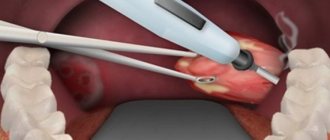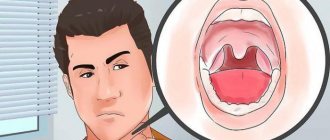Surgery to remove tonsils is performed for chronic tonsillitis, which is accompanied by frequently worsening sore throats. Against the background of frequently recurring tonsillitis, pyelonephritis, periarteritis nodosa, joint diseases, inflammation of the prostate gland, and infective endocarditis often develop. Due to the high risk of complications, experts often recommend surgical treatment of chronic tonsillitis. Often, only surgery can save the patient from constantly recurring relapses of sore throat, which greatly weaken the body’s defenses and reduce the patient’s quality of life.
Innovative technologies available to the specialists of the CONSTANTA Clinic in Yaroslavl make it possible to perform minimally invasive surgical interventions on the pharyngeal tonsils with high efficiency. We guarantee our patients high-quality services from experienced doctors who have many years of ENT practice behind them. Our Clinic is equipped with modern equipment, with which we carry out high-quality diagnostics and monitor the effectiveness of both conservative and surgical treatment of chronic tonsillitis and other diseases within the competence of otolaryngologists.
DIAGNOSIS OF CHRONIC TONSILLITIS
For frequently recurrent tonsillitis, consultation with an ENT specialist is necessary. The sooner you make an appointment with a doctor, the faster the specialist will provide qualified assistance. The doctor makes a diagnosis based on medical history, examination and research results. The main method for diagnosing chronic tonsillitis is pharyngoscopy. During the examination, the otolaryngologist identifies characteristic signs of the disease: swelling of the mucous membrane, fusion of the palatine arches with the tonsils, formation of adhesions, loose tissue, accumulation of pus in the lacunae, enlarged lymph nodes.
The toxic-allergic form of chronic tonsillitis is the most severe. Relapses occur several times a year and may be accompanied by infectious and inflammatory processes in internal organs and adjacent tissues, and the formation of abscesses. The patient experiences severe weakness, the body temperature may rise, and a sore throat causes severe anxiety and reduces the quality of life. The simple form of chronic tonsillitis occurs with more sparse symptoms: the patient is bothered by a sore throat, which intensifies when swallowing and chewing, weakness and decreased performance.
A common mistake made by patients with chronic tonsillitis is uncontrolled use of medications, including antibiotics. With antibacterial drugs you only slow down the spread of infection, but over time, pathogenic microorganisms adapt to the action of even the most powerful drugs, which lose their therapeutic effect. While the infectious focus of the tonsils is in the oropharynx, antibiotics will only provide temporary relief, but will not solve the problem.
How to rinse tonsils at home with an irrigator
It is better to rinse the tonsils on an empty stomach in the morning, since a stream of water entering the larynx can cause vomiting. Such reflexes cease to bother you after regular procedures. The duration of rinsing the tonsils is 2-3 minutes, but you can start from 30-40 seconds until slight discomfort appears in the throat. Washing is performed according to the following algorithm:
- stand in front of the mirror and take the irrigator handle;
- set the jet pressure to the minimum level;
- insert the tip of the device into your mouth and turn on the device;
- When changing the position of the device, turn it off each time.
Before washing, make sure the device is in working order. Fill the reservoir with a suitable solution.
Do not use decoctions and infusions. The smallest plant particles included in them can become clogged in the device’s filter and damage it.
After the procedure, you need to thoroughly clean the nozzle and put it in the case. When washing, do not swallow the solution, as it contains microbes washed out of the lacunae of the glands. Do not tilt your head back to prevent liquid from entering your respiratory tract.
After the procedure, you may feel dry mouth and sore throat. This is a normal reaction of the body to the solution used and the pulsation of the liquid. Subsequently, the larynx will get used to the effects of pulsating water. However, if you experience a sore throat and blood in your saliva, stop using the irrigator and consult a doctor. At home, only preventive cleaning of the tonsils is possible. For tonsillitis, you need to undergo the procedure in the ENT office.
TREATMENT OF CHRONIC TONSILLITIS: WHY OPERATION?
Medical tactics for chronic tonsillitis are selected based on numerous diagnostic data and examinations. Specialists weigh the pros and cons, assess the risks of complications and make professional forecasts for the future.
In most cases, tonsillectomy is performed when a toxic-allergic form of chronic tonsillitis develops, which, unlike the simple form of the disease, occurs with severe symptoms of intoxication, immunosuppression and a high risk of developing infectious complications.
Radical removal of tonsils for chronic tonsillitis is absolutely justified: if conservative treatment of tonsillitis is ineffective, only surgery can get rid of the source of chronic infection in the pharynx and prevent the spread of infection.
Experts identify more than 100 concomitant diseases that occur with long-term tonsillitis: psoriasis, nephritis, eczema, prostatitis, scleroderma, lupus erythematosus, rheumatism and other pathologies. You should not postpone the operation if the specialist insists on it. The tonsils lose their main protective functions and turn into a dangerous source of infection.
There are certain indications for surgical treatment of chronic tonsillitis, on the basis of which the doctor makes a decision on the need for surgery.
Prevention
- Varied and nutritious food.
- Avoid contact with infectious patients.
- Avoid hypothermia.
- Boosting immunity through vitamin therapy, hardening procedures, and daily walks in the fresh air.
- Prevention, treatment of chronic foci of infections (caries, sinusitis, chronic tonsillitis).
- Compliance with personal hygiene rules.
Share with friends
Rate this article: ( 9 ratings, average: 4.67 out of 5)
Loading…
MAIN INDICATIONS FOR TONSIL REMOVAL IN CHRONIC TONSILLITIS:
- joint pain;
- pathological changes on the ECG;
- the development of serious complications that affect the heart, blood vessels, joints and internal organs: endocarditis, pericarditis, glomerulonephritis, pyelonephritis, vasculitis, rheumatism, arthritis;
- chronic intoxication, high risk of developing sepsis;
- development of peritonsillar abscess;
- heart rhythm disturbances, heart pain.
The main goals of surgical treatment are to remove the source of chronic infection, eliminate the symptoms of tonsillitis, prevent the development of infectious complications and stop intoxication of the body. With a highly qualified surgeon, tonsillectomy allows you to successfully perform all these tasks and relieve the patient from constant discomfort.
The operation to remove tonsils should be carried out only within the walls of a medical institution that has all the necessary technical equipment. Our Clinic employs qualified specialists, well trained and experienced, who have many years of practical experience behind them, allowing them to carry out surgical treatment of chronic tonsillitis with high efficiency.
Tonsillectomy has not only indications, but also contraindications. They must be taken into account when choosing treatment tactics. Experts identify absolute and relative contraindications to tonsil removal.
Absolute contraindications include:
- severe heart failure;
- serious impairment of kidney function;
- endocrine pathologies, in particular - decompensated type of diabetes mellitus;
- bleeding disorders, which may be complicated by bleeding or blood clots;
- oncological diseases;
- active form of tuberculosis.
- exacerbation of any infectious and inflammatory processes;
- menstruation in women;
- pregnancy;
- increase in body temperature.
Relative contraindications to tonsillectomy:
Complications of purulent lesions of the tonsils
Self-medication of sore throat, chronic tonsillitis and other diseases that result in the formation of purulent plugs in the tonsils can undermine a person’s health for the rest of his life. As well as a negligent attitude towards this problem, especially if it does not bother you much during a chronic course.
The fact that an abscess on the tonsil is not accompanied by fever and does not hurt does not mean that its presence can be tolerated. This can lead to life-threatening local phenomena such as abscess, abscess and sepsis. And also cause systemic complications caused by the constant entry of toxins and particles of pus into the lymphatic and bloodstream:
- lymphadenitis;
- sinusitis;
- sinusitis;
- pyelonephritis;
- rheumatism;
- endocarditis;
- polyarthritis;
- adnexitis;
- prostatitis;
- cholecystitis.
An untreated sore throat can result in the same consequences when, after the acute symptoms have been relieved and the general condition has improved, the patient independently stops the medication course and observation by a doctor. Meanwhile, the inflammatory process quietly progresses and moves into a new stage of exacerbation or into a chronic form.
As long as there is at least one ulcer or abscess on the tonsil, treatment should not be stopped. Moreover, some purulent plugs and ulcers can only be noticeable during a medical examination.
FEATURES OF PREPARATION FOR TONSILLECTOMY
Before surgery, patients undergo a comprehensive examination. The list of studies includes:
- general blood analysis;
- general urine analysis;
- blood test for APTT, fibrinogen, PTI;
- Blood for RW, HIV, HBs Ag (hepatitis B), HCV (hepatitis C);
- glucose, total bilirubin, blood creatinine;
- fluorogram;
- ECG with interpretation.
5 days before surgery, specialists prescribe medications for patients undergoing surgical removal of the tonsils to reduce the risk of bleeding. Immediately on the day of surgery, you are prohibited from eating and drinking.
You must carefully follow your healthcare provider's recommendations. This will minimize the risk of complications, both during surgery and in the postoperative period.
If, during a comprehensive examination, specialized specialists identify somatic pathology, the operation may have to be postponed. The doctor will prescribe appropriate drug treatment, based on the results of which a decision will be made about the possibility of performing a tonsillectomy.
Pus on the tonsils in a child
Children are more susceptible to diseases than adults, because children's immune systems are not yet fully developed. This also applies to the protective functions of the body. Therefore, if you have any symptoms, you should immediately consult a doctor to prescribe proper treatment.
The disease can be diagnosed after laboratory tests. You should take a blood test and a throat swab. If a child does not have other symptoms, such as fever and acute pain, this does not mean that there is no need to see a doctor. If there are purulent formations, you should consult a specialist to avoid serious complications.
Doctors also recommend visiting an ENT specialist and a dentist at least once every six months, as well as teaching your child to brush their teeth twice a day.
Important! As soon as plaque or purulent plugs on the tonsils are discovered, consult a doctor immediately.
AT WHAT AGE IS SURGICAL TREATMENT OF CHRONIC TONSILLITIS MOST OFTEN PERFORMED?
The operation can be performed at any age, in accordance with the existing indications for surgery. Due to anatomical features, children are recommended to undergo tonsillotomy - partial removal (cutting) of the tonsils or conservative therapy. Adults undergo tonsillectomy - complete removal of hypertrophied tonsils. The minimally invasive nature of surgical treatment of tonsillitis allows for surgical intervention with minimal tissue trauma, without significant blood loss and with a short rehabilitation period.
Tonsillectomy is one of the most common operations in the modern practice of ENT specialists. Despite this, patients must be monitored in the early postoperative period so that qualified Clinic staff can monitor the patient’s health status and, in case of signs of deterioration or complications, provide the necessary medical care.
ANESTHESIA FOR TONSILLECTOMY AND TONSILLOTOMY
Tonsil removal surgery can be performed under general anesthesia or local anesthesia. The decision to use one or another method of anesthesia is made by the doctor based on the medical history, examination results and examination of the patient. Local anesthesia today is rarely used in early childhood, since due to the mental characteristics of a child under 8-10 years old, he cannot calmly accept the operation. Therefore, we recommend that tonsillectomy be performed in childhood using short-term general anesthesia.
At the CONSTANTA Clinic, tonsillectomy is performed under video microscopy control. During surgery, an anesthesiologist is present in the operating room and fully monitors the patient's condition. Modern drugs that we use for general anesthesia are not accompanied by the development of complications characteristic of drugs used earlier. The patient quickly comes to his senses and recovers under the strict control of competent Clinic specialists.
How to get rid of ulcers on the tonsils for pregnant women and children
These are special categories of patients for whom many medications are contraindicated, while the immune system is not working at full strength. For pregnant women, sore throat is dangerous at any stage. In the first trimester, the disease can cause severe toxicosis, the threat of miscarriage, or disrupt the development of the unborn child.
At any time, typical complications of the disease may occur, as well as a weakening of labor due to a general decrease in the body’s defenses. Ideally, chronic tonsillitis is treated at the stage of pregnancy planning.
In a situation where abscesses on the tonsils appear in a pregnant woman, the therapist and obstetrician-gynecologist decide how to treat the disease. First of all, topical medications, antiseptic and anti-inflammatory rinses will be prescribed.
If in a serious situation the doctor prescribes antibiotic treatment, you should not refuse: they will bring more benefit than harm.
Pustules in the throat in infants under one year of age are usually treated in a hospital setting: the risk of rapid development of edema and severe intoxication is too great. In children older than one year, it is somewhat easier to treat ulcers that appear on the tonsils: they have already developed their own immunity. But he is still too weak to get rid of the pus without antibiotic therapy.
Children under 3 years of age are very prone to allergies, therefore, without consulting a pediatrician, not only antibiotics, but also herbal remedies should not be used to treat them.
To reduce the temperature from 38 °C, both pregnant women and babies are prohibited from taking aspirin . Only paracetamol-based drugs are allowed. You cannot steam your feet, do steam inhalations, or perform any other warming procedures.
GENERAL ANESTHESIA FOR TONSILLECTOMY
Removal of tonsils under general anesthesia is used mainly in childhood. Before the operation, sedatives are prescribed. The anesthetic is administered intravenously, which allows the patient to quickly fall asleep. After this, the doctor begins to remove the tonsils. If during the use of local anesthesia the patient sits and is conscious, then during surgery under general anesthesia the patient is in the operating room in a lying position with his head tilted back.
The operation takes place quickly, under the supervision of experienced specialists. Tonsils are removed using a raspator, a tool that provides low-traumatic removal of hypertrophied tissue while preserving the functional characteristics of healthy mucosa. The vessels coagulate, so bleeding does not occur. The doctor carefully examines the tissue after removing the tonsils to assess the condition of the bed and blood vessels. It is important to perform the tonsillectomy as cleanly as possible, leaving no part of the tonsils behind. This will provide a guarantee against relapse of the disease in the future.
Is it possible to rinse tonsils with an irrigator?
An oral irrigator is a device that, by supplying pulsating water, cleanses the teeth and gums of food debris. According to dentists, regular use of such devices helps prevent the development of caries, gingivitis, periodontitis and other dental diseases. The irrigator should be used as an additional hygiene product, along with a toothbrush and floss. You need to use it at least 2-3 times a week, and better yet, every evening after traditional teeth brushing.
Modern irrigators are multifunctional devices that are suitable for cleansing the oral cavity, massaging the gums and rinsing the tonsils. The device reservoir should be filled with plain water or a disinfectant solution, furatsilin and other products approved by a doctor and compatible with a specific device. Let's learn how to wash your tonsils at home using an irrigator.
FEATURES OF THE POSTOPERATIVE PERIOD
Despite the fact that tonsillectomy is one of the most common operations in modern otolaryngology, the patient’s condition must be monitored by qualified specialists in the postoperative period. The patient is transferred to the ward on a gurney or in a sitting position, depending on the type of anesthesia used. For quick recovery, it is recommended to use dry ice every two hours for 5-15 minutes. This prevents the appearance of swelling and inflammation.
Feeling is restored a few days after the operation. During the first day, you should not swallow saliva - you need to keep your mouth slightly open so that it flows by gravity. In the early postoperative period, you should not talk. If minor sore throat occurs, the doctor will prescribe a pain reliever. He also recommends the use of non-steroidal anti-inflammatory drugs, which, in addition to the analgesic effect, prevent the development of an inflammatory reaction. In general, patients tolerate the operation easily and can return to their usual activities almost immediately.
During the first days after surgery, you can eat mostly soft, pureed foods. Avoid hot drinks. According to indications, specialists can prescribe medications to prevent bleeding. Antibacterial drugs are used to prevent the development of infectious complications.
For two weeks after surgery, physical activity is limited. It is forbidden to visit the bathhouse or actively engage in sports. You should also not actively gargle for the first days after tonsillectomy.
Basic recommendations: how to properly rinse tonsils at home
Experts advise adhering to the following rules when washing your tonsils:
- choose only high-quality irrigators with several operating modes and the ability to regulate pressure;
- wash your tonsils to prevent tonsillitis if it has already been diagnosed once;
- carry out the procedure in courses of 5-10 procedures with intervals of several months;
- during the period of preventive treatment, avoid spicy and hard foods (crackers, chips, etc.), which can burn or scratch the larynx;
- After rinsing, gargle with an antiseptic solution.
CONSEQUENCES OF TONSILLECTOMY
Tonsil removal surgery is successful in most cases. A huge role is given to the professionalism of the operating doctor, anesthesiologist and other specialists who monitor the patient’s well-being. If you contact a competent otolaryngologist, who has the necessary technical equipment, and follow the doctor’s recommendations before surgery and in the postoperative period, then the risk of complications is minimized.
When the first signs of malaise and deterioration in health appear, you should consult your doctor. Since the pharyngeal tonsils have a rich vascular network, after tonsillectomy there remains a risk of bleeding. Therefore, if the doctor discovers prerequisites for blood loss, the operation is postponed or additional medications are prescribed to prevent bleeding during surgery or in the first days after it.
The first week after surgery is considered the most dangerous. During this period, tissue healing and rejection of fibrin formed at the site of the removed tonsil occurs. Do not take any action on your own. Contact qualified specialists of the Clinic who will provide the necessary amount of medical care and prevent the development of serious complications.
After tonsillectomy, cases of relapse of the disease cannot be excluded. But the high professionalism of our Clinic’s surgeons and the use of innovative technology make it possible to minimize any risks and ensure maximum infectious safety for our patients.
How to remove pus from tonsils yourself: can you squeeze it out?
It is not recommended to remove any deposits or formations on the tonsils yourself.
This can lead to injury to the mucous membrane if handled carelessly.
In addition, the products used may have a burning effect. As a result, such amateur activities can aggravate the underlying disease.
Currently, a popular method is when the patient, standing in front of a mirror, uses a cotton swab to press on the tonsil. When pressed, pus flows out or a hard plug comes out.
However, if excessive force is applied, surrounding tissues can become infected. Also, ulcers can be squeezed deep into the tissues and lead to the formation of an abscess.
Therefore, removing pus from the tonsils using this method should be done with caution, and it is better to entrust it to a specialist.










